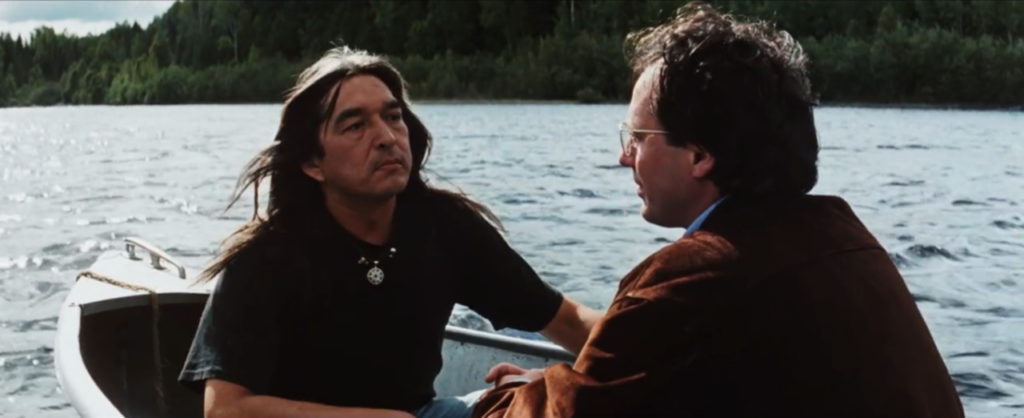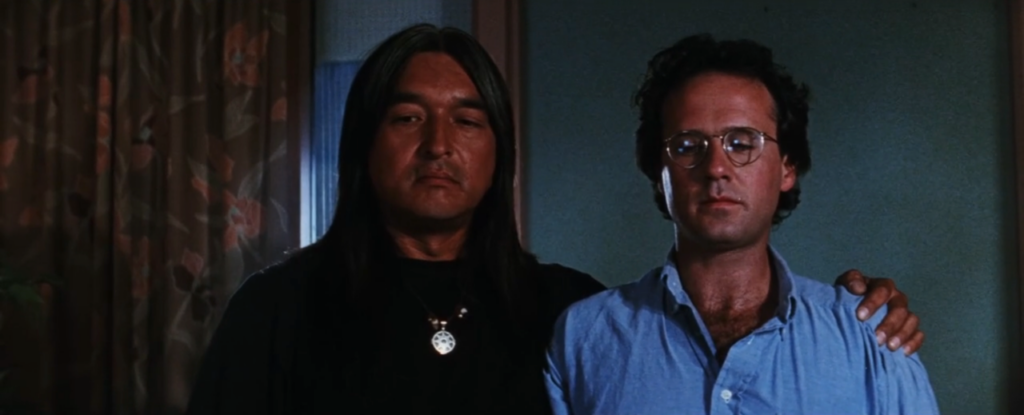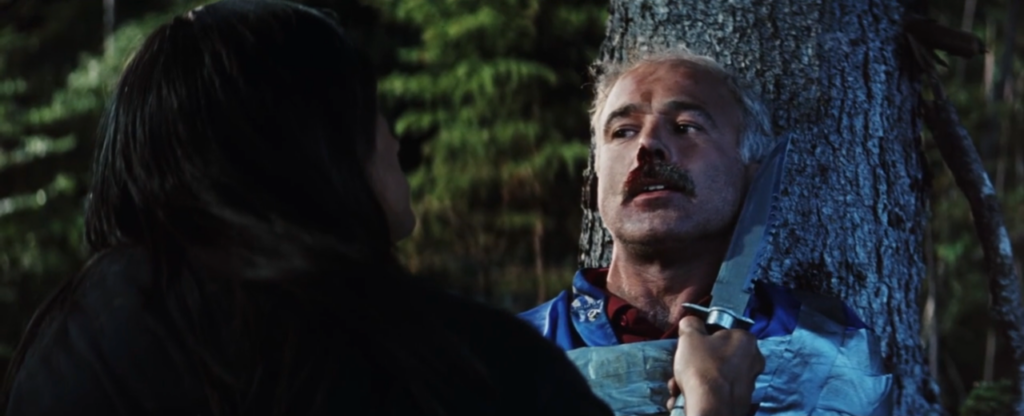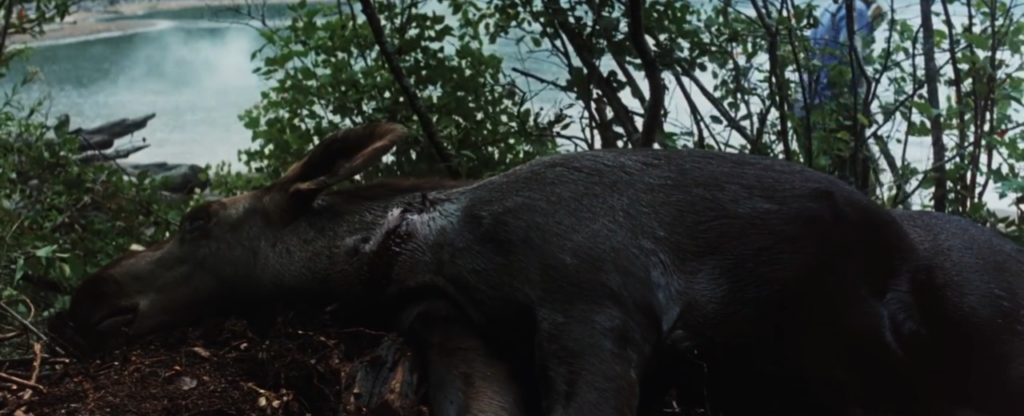| Chelli Riddiough |

A new restoration of Clearcut plays at the Trylon Cinema from Friday, July 26th, through Sunday, July 28th. Visit trylon.org for tickets and more information.
I first saw it embroidered on my coworker’s hat: “You are on Native land.” Then I noticed it emblazoned in neon signage at Owamni, the indigenous restaurant. Those five words: are they a fact? A reminder? Are they meant to spark remorse? To start a revolution? Or are they simply meant to sell hats?
Even before I started seeing those five words around town, I was acquainted with land acknowledgements. As a graduate student at the University of Minnesota, I’d seen and heard a variety of them, from the straightforward to the self-flagellating. They were always made by white people in positions of power—professors, administrators. They struck me as empty virtue signaling. At the same time, I wondered if for the Native students in the crowd they made a difference. As a white woman, I knew my skepticism of land acknowledgements was irrelevant at best and cancellable at worst. Turns out, I’m not the only one who finds fault in them.
A friend of mine recently attended a conference at a casino in Northern Minnesota. On the first day of the event, a Native man stood in front of the crowd and asked a white man in the front row for his keys. Though taken aback, the man in the front row obliged. “Here’s what I think of land acknowledgements,” the Native presenter said. “I acknowledge that I have your keys.” Then he pocketed them. Later in the day, he returned to the stage and called up his son. Solemnly, he handed the white man’s keys to his son. “I acknowledge that my son now has your keys,” he said.
I thought about this story when I watched the 1991 film Clearcut, which addresses issues of Native land sovereignty and white guilt in a similarly head-on manner. Our protagonist is Peter Maguire, a well-meaning white lawyer representing a Canadian First Nations tribe whose land is being razed by a logging company. The first exchange of dialogue between Maguire and Wilf, a Native elder, cuts right to the chase. “Hello white man,” Wilf says. “Hello Indian,” Maguire replies. Instead of racial tensions being a subtext or simmering tension, they’re front and center. This is a catharsis of its own.
At the film’s start, Maguire has already failed: his defense of Wilf’s land has lost. This is the first of many factors contributing to Maguire’s impotence. He seems stuck, repressed, unable to express anger. Later that night, he’s kept awake by a loud gathering happening in the motel room next door. Annoyed, he mutters to himself, “Shut up, you stupid…” but can’t finish the sentence. He catches himself. Then he punches a wall.
Maguire’s inability to act becomes a turning point for the movie when we meet our other protagonist, Arthur. Played by a deadpan, fed-up Graham Greene, Arthur is the id to Maguire’s superego. The two men first meet on a dock while Maguire is recovering from a sweat lodge experience. Arthur approaches Maguire and lights up a cigarette. “So,” he says, “what does a man who talks for us do for us?”

Arthur and Maguire face off in a canoe.
Maguire may take Arthur’s words as a casual remark, but they’re actually a deadly challenge. Clearcut continuously examines the tension between talking and doing, and it’s clear from the jump that Maguire is all talk. Early on, he complains to Wilf, “Your world is turning to shit […] People like me have done you no good.” Wilf replies: “Who do you feel bad for: us or yourself?” Maguire might claim to feel bad for Wilf’s people, but it’s clear he mostly feels bad for himself. He is a failed ally, a social justice warrior without a cause—and that is unforgivable.
In his first exchange with Arthur on the dock, Maguire acts the part of the enraged ally: he claims that he’d like to kidnap Bud Rickets, the mill manager, and skin him alive. It’s a hyperbolic statement, more of a pandering than a promise made. In a way, it’s similar to a land acknowledgment: Maguire is letting his Native audience know that he is hip to their struggles, and if left to his own devices (watch out now!) it would be all over for big, bad Bud Rickets.
The genius of Clearcut is that Arthur takes Maguire’s supposed desire for retribution—his white guilt—and makes it manifest. Later that night, while Maguire is fuming over the loud gathering happening next door, Arthur enters his motel room. “Let’s do it,” he says. “What we talked about.” It’s a testament to Greene’s performance that Arthur’s words, and subsequent actions, could be interpreted in many ways. Is he calling Maguire’s bluff to kill Rickets? Is he taking the piss? Is he pushing Maguire to recognize his own agency and power? Is Arthur a psychopath? Or is he the sanest person in this film? Regardless of which, or how many, of those questions prove true, Arthur is dead-set on forcing Maguire to claim his sense of power. He starts by daring Arthur to confront his noisy neighbors politely and see where that gets him. Maguire does so, and is in the process of being emasculated when Arthur bursts into the room with a knife. Thus begins the story’s stage of Maguire-as-hostage/Maguire-as-accomplice. Arthur forces Maguire to help him tie up the hostages, taunting him: You’re the one who wanted them to quiet down! He forces Maguire to make his complicity (his agency? his authority?) explicit.

Arthur and Maguire stand side by side in the motel room. Arthur has his arm around Maguire’s shoulder. It’s unclear whether Maguire is his victim or his accomplice.
In the hotel scene, Maguire is more of a captive than a willing participant, and he plays the victim well. “Violence will accomplish nothing! Nothing, do you understand?” he shouts. “Now just who are you lying to?” Arthur replies. Yet when Maguire intervenes and stops Arthur from bashing in one of the captive’s heads, Arthur listens. It’s almost as if he’s saying to Maguire: See? You can change things.
Arthur then forces Maguire to accompany him as he accosts and kidnaps Rickets. The majority of Clearcut plays out as the three men go on a journey through the forest—the same forest that’s at risk of being razed—with Arthur continually raising the stakes of the danger that Rickets is in. At first, Maguire desperately pleads with Arthur, trying to act the moral compass: “Stop before it’s too late.” Rickets, more annoyed than terrified, looks to Maguire for help but also mocks his career working for “one good cause after another.” In a different manner than Arthur, Rickets wants Maguire to confront his complicity as a white man. As a member of a dominant majority, you either commit the crimes or reap the benefits. While Maguire has fought against the harm done to Canada’s First Nations people, he’s also lived in the world that those harms have created. He’s a successful lawyer with an apartment in the city. He’ll be fine. Maguire’s central struggle is with the very concept of violence. He cannot abide by the damage that Ricket’s logging company is doing to Arthur’s tribe, but he also cannot abide by the damage Arthur is doing to Rickets in real-time. In one of Clearcut’s most graphic moments, Arthur removes the skin from Rickets’s leg with a knife. Maguire is apoplectic: “What are you doing to him?” “Debarking him,” Arthur replies. “You wanted him hurt, right? Skinned alive is what you said.” Maguire begs him to stop, to which Arthur replies, “Stop me.” Maguire lifts a rock but can’t bring himself to throw it at Arthur’s head. He’s in the ultimate pacifist’s quandary: witness to violence on both a large, abstract scale and an up-close-and-personal one, unable to act without harming one side or the other.

Arthur holds a knife to Ricket’s throat. Ricket is bound in duct tape and is pressed up against a tree.
Clearcut struck me as a predecessor to Jordan Peele’s Get Out, in which a Black man is held hostage by a cult-like white family and must kill them to survive. You may be familiar with the horror sub-genre of the rape-revenge film; Get Out and Clearcut form a parallel genre I’d like to call “race-revenge films.” Race-revenge films are cathartic for both liberal white audiences, who get to cheer for a victim-turned-hero protagonist of color, and for audiences of color, who get to watch the logical (yet impossible) recourse to racism on screen. Race-revenge films, much like rape-revenge films, constitute a form of psychodrama, one that feels cathartic but could never be realized in real life.
Whereas Get Out is more of a fantasy about fighting back against larger-than-life racist villains, Clearcut is about the impotence of well-meaning white people existing in a systematically racist society. (The impotence can be read literally, too—at one point, Arthur mocks Maguire’s “limp white dick.”) While Arthur is furious about the injustices his people have suffered, he seems more angry at Maguire than at Rickets. Rickets may get the sharp end of Arthur’s knife, but Maguire gets his scrutiny. Arthur seems to be saying: Do something! Anything! And for those who would argue that Maguire has done something with his law defense, well, that’s not good enough. Arthur cares less about killing Rickets, who he knows will never change, and more about getting Maguire to step up.
Toward the end of the film, Arthur gets what he wants. Maguire stands up for himself, bringing his principles from the abstract to the embodied. Yet it’s an ambiguous ending, one in which the white men aren’t duly punished for their crimes. This sets Clearcut apart from Get Out and also makes its ending ring more true. So rarely in real life are perpetrators held accountable for their actions. As for the allies? They move on. At one point, Arthur tells Maguire, “You’ll forget.” And he probably will.

A moose lies dying from a gunshot wound. Maguire passes by in the background of the frame.
During their hostage journey through the forest, Arthur and Maguire encounter two white hunters searching for a moose they may have shot. Maguire begs them for help, but Arthur has a gun, and the two hunters end up fleeing. Later, as Arthur, Maguire, and Rickets continue their journey through the woods, the camera pans to a dying moose lying on its side. The hunters were successful; they shot to kill. It’s a striking image, one that drives home the truth that Arthur knows: As white people go about their lives, there’s always collateral damage. There’s always damage.
Edited by Olga Tchepikova-Treon
